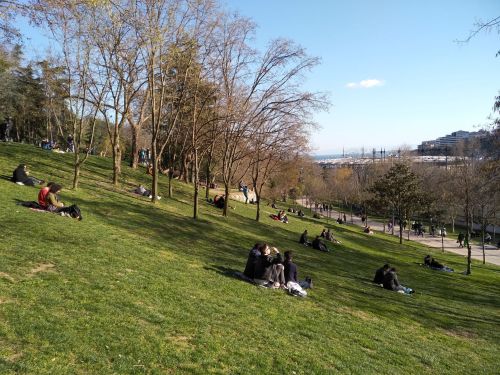
Most ANAMED fellows reside on the Center’s premises, in a newer edifice annexed to the main building, whose historic front proudly stands on the always busy, noisy, and never resting İstiklal Caddesi.
The residential units, withdrawn to the back, overlook a narrow, steeply descending, and much quitter alley instead. However, this does not provide a complete protection from the loud pop and folk music and other sounds generated by the main avenue’s street musicians, night clubs, and cheering crowds, all the more pronounced in the evening. Upon stepping out from the building, one is immediately taken by the flow of passing people, which on warm and sunny days is a veritable human river, swollen as if after a mountain snowmelt and bound only by buildings, whose tall stone, plastered, or concrete facades leave the impression of a deep canyon that, only in certain moments of the day, permits some rays of sun to hit its bottom. The comparison with a river is not an exaggeration; some statistics report that on a summer weekend day nearly three million people (sic!) walk a part or the whole length of this long artery. Despite being a pedestrian zone, crowds are often ploughed through by historic trams, public security cars, delivery and garbage trucks, and taxies, all regularly operated by nervous and inpatient drivers. In such a situation, one has to remain focused and use his maneuvering skills to get through, escape vehicles, and avoid face-to-face collision with other people, particularly when not on a leisurely walk, but in a rush. This constantly moving, pushing, and squeezing mass of curious foreigners, amazed country folk, and busy locals only partially loses its members to side streets, historic churches, famous brands’ fashion stores, or tourist-pitched sweetshops, whose street windows are crammed with innumerable kinds of baklava, ‘kadayıf’, and ‘lokum’ (Turkish delight). But the temporarily “lost” people are immediately replaced by those who leave these attractions. And there is almost no way to avoid the street or take a shortcut—the century-old communication pattern has to be followed.
Why am I describing this well-known street and the experience of it, shared with all who ever walked along it? I think it represents the whole Istanbul in a nutshell, as the same crowd, haste, and noise, only of a less intensity—this certainly cannot be claimed for places like Eminönü—can be found pretty much everywhere in this hyper-grown metropolis spreading along the shores of two continents, which have symbolized the East and the West, colliding and blending at this unique spot. Even in parts of the city where it is not so, one generally is overwhelmed by the intensity of history, architecture, visual attractions and gastronomical lures, musical performances, and other offerings of pleasures for both body and mind. And Istanbul’s tendency to change almost daily makes one desire to always be there, to seize the opportunity, ready to dive in and submit to the dictates of a dynamicity that sucks one in and provides enjoyment, but also drains lots of energy. As Zeynep Aydoğan expressed well in her earlier blog entry, “this is what Istanbul does. It changes constantly. It consumes people and places, not the other way around. Istanbul does that in order to stay alive.”
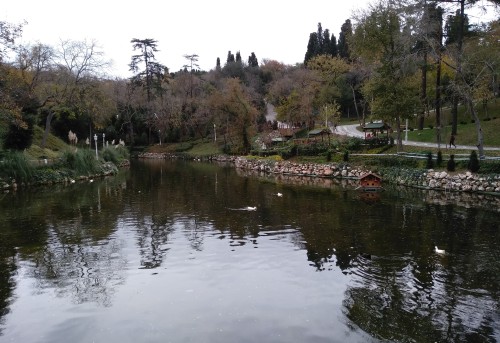
Yıldız Parkı
What does one do if one wants to be set free from the city’s clutches, even just for a moment? Is there a way out, to take a break and catch a breath? Is it possible to find a peaceful spot in an urban agglomeration that stretches for tens of miles in all directions? Can one pause to process daily arriving impressions, reflect on life and experiences, hear one’s own thoughts, and feel one’s own heart beats? For the past six months, I have discovered in this urban desert of sorts some oases of peace, which quenched the thirst for quiet moments and answered my need to recharge psychologically and spiritually. They also triggered reflections on human nature, culture, religion, art, literature, and times past and present, as they were created consciously or not so much so in various periods of the long history of the city. Here, I want to share some of these thoughts, as well as the impressions of the quiet retreats I have come across, which are well knit into the city’s physical, historical, and mental maps, but in the same time remain out of them, undevoured by Istanbul the Beast.
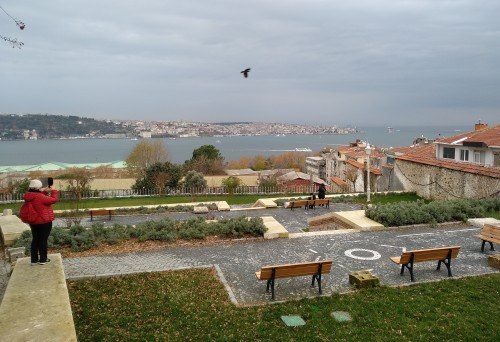
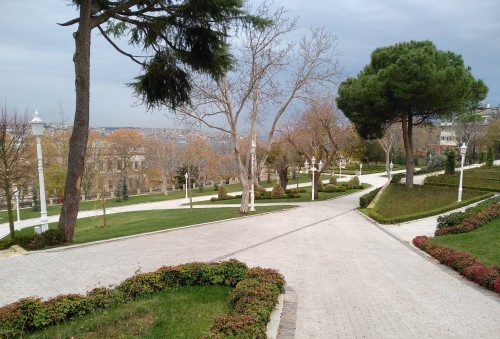
Yıldız Parkı, terraces
Already towards the end of October, after just more than a month of living in Istanbul, I experienced a great deal of discomfort, as if suffocating among the buildings. I wanted to get out, I needed open space and natural surroundings. But where to go? I still did not know the city very well back then. I sort of knew Beyoğlu, our immediate neighborhood, which is densely built, with almost no greenery anywhere around. I wanted to get out, be in an open space, possibly somewhere in the countryside, as the weather was uncommonly warm and sunny for that time of year. But, all such places seemed too far away on the map. Fortunately, I ran into Zeynep, related to her my urge, and she came up with the idea for us to go to Maçka Demokrasi Parkı. I did not know anything about it, but I agreed with the proposal, trusting her long and good experience with the city and relying on her similar desire to get out. However, in order to get there, we needed to make a sacrifice: to walk almost the entire length of İstiklal Caddesi. And it was not only a sunny Sunday, but also the day before Republic Day, a major public holiday, which meant that the avenue was triply more packed with people than normal. We gathered our mental strength and jumped into the dense and wavy river running between tall buildings. We swam courageously, taking additional effort to fight multidirectional currents when we emerged on Taksim Square. Once we were in Gezi Parkı, however, with a fair amount of trees, a little fresher air, and less people, I started to feel relieved. Conveniently, there was a park-like extension stretching between the Divan and Intercontinental hotels and a pedestrian path enabled us to walk through the block and avoid traffic. Soon we reached our destination: I was struck by the view of a deep, wooded valley opening in front of me, spreading all the way down to the seashore. It appeared larger than on the map and, with the configuration of sloping terrain and the buildings of Taşkışla and Nişantaşı neighborhoods concealed by the tall trees of the park, it felt as if completely out of the city. I finally could immerse myself into the openness and fresh air, gently interrupted only by fragrant breezes coming from the sea. Despite the presence of a great number of people, who also came to enjoy the good weather and have fun with families and friends on the day free of work, it was a much relaxing experience. Suddenly, I realized: here is how the İstanbullular (İstanbulites) get away from the kalabalık (crowded) nature of the city. Parks are of vital importance for them. They provide a place to relax, but also to bond with family and friends, the connection with whom we so easily loose nowadays, constantly bound to the screens of our computers and smartphones.

Yahya Efendi Tekkesi
The next time I felt the same urge to get out, I ventured in the same direction, but now farther away. Compelled to explore the European shore of the Bosphorus, I walked by Dolmabahçe Palace, a huge imperial palace complex from the mid-19th century, by Çırağan Palace, another late Ottoman residence, and ended up in Yıldız Parkı, once the enclosed garden preserve of the sultan and his family, now an open public park. After the two palaces and their gardens—which were likely inspired by Versailles and similar European royal palaces and relied on the grandeur effect provided by their seafront location—this one, originally used by sultans as their hunting ground, was more in line with the contemporary tendency among the European elites to retreat from their formal palaces—which were like small towns—to smaller and humbler residences set in nature. The complex of pavilions dispersed across vast grounds cleverly uses the wooded slopes along a stream, which waters irregular flower beds and sections planted with exotic bushes and trees. My ascending a steep paved path was well rewarded. The peace and natural setting were disturbed only by cars that bring some visitors to the central areas and a wedding reception taking place in one of the former palace pavilions, Çadır Köşk, accompanied by a reflecting pool. On the other hand, descending through terraces set behind Çırağan Palace but on higher levels offered vistas to the Bosphorus, Sea of Marmara, and their Asian shores. Here I understood better the process of the gradual migration of upscale citizens out of the historic city. Perhaps it was first the establishment of the foreign embassies’ in Pera, along the road out of Galata, which afforded them with airy views on the sea. The state officials and notables constructed their yalıs (seaside mentions) along the Bosphorus and villas on the Adalar (Princes’ Islands) at the same time or even earlier. Slightly later, the sultan himself followed suit and left the century-old, almost sacred confines of the Topkapı Palace to move first to Dolmabahçe and then seek further retreat or, rather, personal safety at Yıldız.
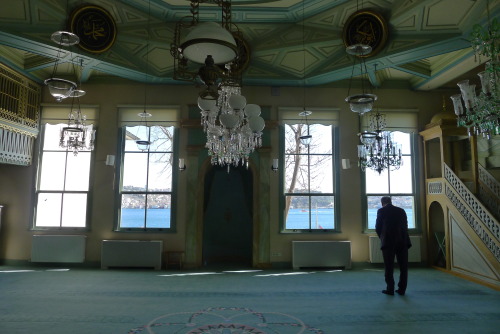
YET, tevhidhane with a view
Close to the main entrance of Yıldız Parkı, I discovered a sign inscribed with “Yahya Efendi Türbesi (Tomb),” pointing to an almost hidden, sharply curving road on a steep slope. My interest in funerary architecture, spiced up by a hint of curiosity, made me determined to brave that acclivity. I was a bit disappointed by the simple architecture of the ‘türbe’ (mausoleum) and the rest of buildings that enveloped it, despite it being designed by the great Mimar Sinan, as I later discovered. But I was hugely impressed by the location of the complex, nested high above and overlooking the Bosphorus, and even more by the tranquility of the place. Although being very close to a busy boulevard that ran almost directly below it, the grounds were fully isolated from it and its noise. This state of peace and calm was similarly undisturbed by a great number of people that came on a Sunday afternoon to visit and pray at the tomb of Yahya Efendi. Their reverence and quietude indicated that this is a special place. And then I entered the ‘tevhidhâne’ (a hall in a dervishes’ lodge reserved for both communal prayers and Sufi rituals), attached to the ‘türbe’ and connected to it through a large railed opening. The simple wooden room provided a chamber atmosphere; moreover, the ‘mihrab’ wall was pierced by four large windows and afforded an amazing view of the Bosphorus and its still mostly wooded Anatolian shores. Originally, this must have enhanced prayerful mood and inspired contemplation among local dervishes during their theological and mystical gatherings. Today, the room is isolated from the outer world’s hustle and bustle, but opening to its natural beauties undoubtedly still has the same effect on the faithful coming here to pray. This and a very picturesque and well-maintained graveyard that has developed from the ‘tekke’ (dervishes’ lodge) up the hillslope—boasting many ornamentally carved 19th-century tombstones and tall cypress trees, and preserving the now-rare outlook of an Ottoman cemetery—revealed to me another type of calmness that this place offers, of a religious and meditative kind, inviting philosophical reflection. Many cats that hung around the grounds also appeared pensive, as immersed in meditation, reflecting the calming properties of this unique place. Or were they just so well nurtured by and rained with attention from pilgrims and visitors who made them enjoy this “paradise regained” and not want to leave it? Anyhow, it became apparent that citizens of Istanbul, before developing (or importing) an interest for parks, had another type of green and peaceful areas available for retreat, strolling, and contemplation—cemeteries. They were gardens of memory. Or oblivion. The latter may have given the reposed and buried therein a final rest and peace, after those who had bewailed them ceased to mourn and frequent their tombs. Smaller and easily accessible cemeteries were those formed in the yards of city mosques and ‘tekkes’, and particularly around the tomb of a locally venerated holy man. But there were large ones that stretched outside the land walls, leaning on Christian burial grounds and continuing the practice dating back to the Late Antique period.

YET, graveyard
Another type of oasis of peace could be encountered in the city itself, such as historic churches and mosques. Generally, walking through the old town, on its narrow and winding streets, although nowadays often lacking the historic wooden buildings and their charm, offers quietness and calm. People living in such neighborhoods seem to lead simpler lives, paced by a much slower rhythm than those in the rest of the metropolis. It actually feels as if being in a small provincial town, not at all as in one of the largest cities of the world. I have often been met by folks casting curious but benevolent looks on a guy who was obviously not a local, wondering what brought him to their quarter. An old lady living in a modest dwelling at the front of Eski İmaret Camii waved from her window to Ayşe and me when we went to visit the building. With lots of genuine joy and affection for fellow human beings she even got out to greet us, exchange a few sentences, and see us off with good wishes and blessings. I love visiting the Kadırga Mehmet Sokollu Paşa Camii complex whenever I find myself in that part of the historic peninsula. I am always amazed by its effective architectural layout and design solutions, carefully and cleverly adjusting to the shape of terrain and the given urban pattern of the surrounding streets and blocks, but in the same time making the inner grounds and buildings isolated from them. I particularly like entering the compound through its back gate and walking through a longish, corridor-like path that goes along a small graveyard, which makes its presence known to a passer-by through a series of railed openings in the stone wall that encloses it and encourages a change of mood and a calming after walking busy streets. Then I emmerge at the not so big, but monumental, stone-paved, and always brightly lit front courtyard. It is also almost always filled with local school kids playing soccer, which fills my heart with joy and brings a smile to my face. This is a city “noise” that does not bother me. Upon entering the mosque itself, dimmed lighting and chamber atmosphere transport a visitor to quietude and concentration, enhanced by a subtle geometry of the interior space and a handsome decoration of its walls.
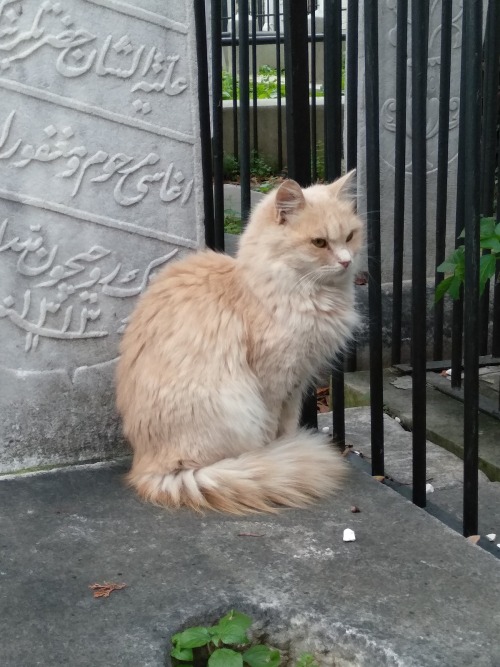

YET, cats
Still surviving and thriving, there are islands of greenery and peace, once outside or on the outskirts of the city, now engulfed by it, that provide a refuge for those seeking a break from fast-paced everyday life. Such is the Monastery of Zōodochos Pēgē (Life-Giving Spring), Balıklı, which is—in addition to tall walls that encompass the compound—isolated from the urban areas and busy traffic corridors by vast tracts of old and new, Christian and Muslim burial grounds. Or Heybeliada, the only of the Princes’ Islands that I have had the chance to visit thus far, which is similarly protected by the Sea of Marmara. In fact, it is the prohibition of motor cars, evergreen wooded hills, and the appeal of a small Mediterranean village once hosting moderately mondaine inhabitants that make it an escape destination. I happened to be there on a cold, cloudy day, which made it even quieter. I literally felt my inner rhythm slowing down, letting me indulge in a relaxed cup of tea in a somewhat hippie café and enjoy a good meal in an authentic seafront restaurant. Upon returning to Beyoğlu, I felt as if I had been away for at least a week, that much was I rested. Another such place, the Rumelihisar campus of Boğaziçi University, was where I spotted a fruit tree in blossom (bahar) this year, my favorite sign of just arrived spring, something one cannot find in overbuilt Beyoğlu. The fragrant scent was in the air despite chilly and rainy weather. Also, the breathtaking views opening from there downhill attracted me again to the Bosphorus. I soon returned to the area, circumventing and postponing the inspection of the impressive castle Mehmet II, built shortly before and in preparation for his conquest of Constantinople, in order to visit the adjoining Aşiyan Cemetery, enjoy the tranquility and vistas the place offered, and search for writers Yahya Kemal, Orhan Veli, and Ahmet Hamdi Tanpınar, all buried in this resting place that can boast possibly the most romantic location in entire Istanbul. The epitaph from Tanpınar’s tomb, featuring verses from a poem by Kemal, speaks not only of the former, but perhaps well encapsulates the position of this attractive cemetery and many other places in the city that may serve as a retreat from it:
‘Ne içindeyim zamanın
Ne de büsbütün dışında’
(Neither am I within time
Nor completely out of it)[2]
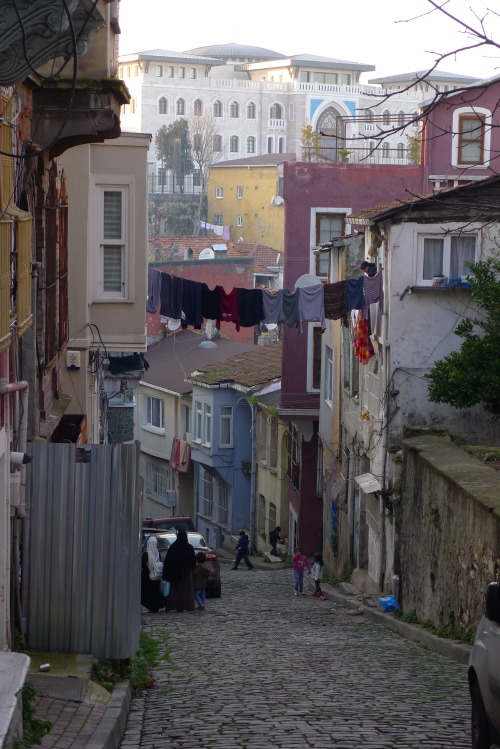
Old City
On one recent weekend, I wished to go somewhere on the Bosphorus again. I went to Eminönü, as I expected that there would be boats—as taking a bus or train, with their crowds, was out of question—departing for places beyond Üsküdar and Beşiktaş. But I was wrong, or simply could not find the right pier. It was sunny and hot, and the whole area was packed with people, all of them hectically running who knows where and pursuing who knows what. All of the sudden, I got extremely exhausted, decided to abandon the idea of faring along the Bosphorus, and, perhaps for the first time, I felt a strong urge to get back to my room and isolate myself from the external world. From time to time, one does need complete solitude, turning inwards to an internal I, in order to regenerate. This made me reflect on and better understand monasteries that were founded within the confines of Byzantine Constantinople and, likewise, dervish lodges built in Ottoman Istanbul and its suburbs. Both were in the city, but turned partially away from it and oriented inwardly (and upwardly). The case of Yahya Efendi (1495–1571) and his establishment is particularly interesting and somewhat emblematic. He was a close friend and ‘sütkardeşi’ (milk-brother) of Süleyman the Magnificent, Islamic scholar, and professor at the Fatih Medrese, but was better known as a mystic, a modest and holy man, after his death revered as one of the four patron saints of the Bosphorus. In the 1530s, he bought land in the vicinity of Beşiktaş, made his residence there, and established a ‘tekke’—the one I described earlier—which originally included a ‘tevhidhâne’, ‘medrese’ (religious school), ‘hamam’ (bath), and houses. He escaped the city and vainglory, but did not sever his ties with the city and Süleyman, who occasionally came to visit him and sought his counsel. The elevated location of the complex overlooking the Bosphorus indicates a desire to (re)connect with nature, testified by Yahya’s efforts in planting trees there and by the ‘tevhidhâne’ being afforded a fabulous view of the Bosphorus. Did he and his followers used to watch ships passing-by, navigating the waterway that looks from here just like a broad river flowing to distant, uncharted, and dangerous lands, such as the mythical Colchis and Hyperborea, which has stirred human imagination since times immemorial? And what did this mean to them: did it speak of the passage of time, point to (or warn of) the limits of human earthly existence, or that there was so much concealed behind the world they saw and knew? Was this his “fikir bayır” (“the hill of thoughts”), as a Belgrade paşa poetically and philosophically referred to the hilltop location of the fortress he was commander of, overlooking the confluence of two great rivers, the Danube and the Sava, the place that inspired him to reflect and where he was eventually buried? Belgrade’s centuries-long position on the border of two empires, Habsburg and Ottoman, and its position in the permanent warring between them, certainly provided an additional reason for reflection. The ‘paşa’ had to fight with Austrian armies, as Yahya was perhaps similarly engaged in the war against the temptations of earthly fame and vanity. The choice of the place overlooking the Bosphorus as his retreat, battlefield, and final resting place is not surprising then. And I wonder if late Ottoman viziers, generals, and admirals—many of them actually devotees of Yahya Efendi and buried in his tekke’s graveyard—may have followed his example in building their yalıs along the Bosphorus. Contemplative and devoted to spiritual pursuits, or not, it is along this mythical waterway that many well-off ‘Istanbullu’s also sought their refuge, in this life and after death.
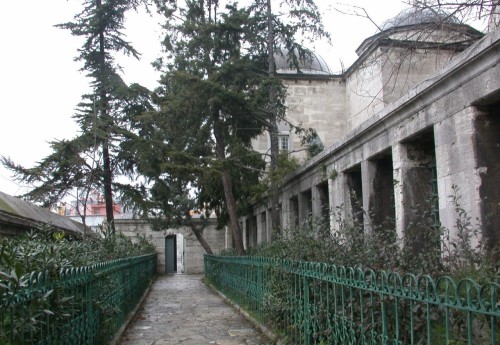

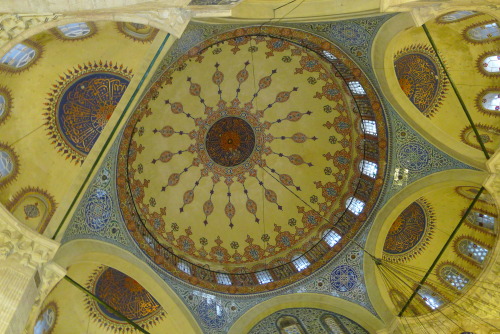
Sokollu Mehmet Paşa Camii
Now, back again to my late October day at Maçka Park. Inspired by the example of merry crowds lounging on the lawns, Zeynep and I grabbed some refreshment and ‘kuruyemiş’ (dried fruits and nuts) from a market, found a nice sun-drenched spot on the grassy hillside, and spent the rest of the day there. We talked about everything—ourselves, life, studying, being academics, living in Istanbul—slowly getting to know each other better. I, perhaps for the first time, felt as a true ‘Istanbullu’: I was in a park, chilling out, and sitttting with a good friend by me. And having friends in this city that easily crushes its inhabitants is another sort of refuge and sanctuary, helping one to recover, recharge, and get back to the street even stronger. Saying this, I recall many hours spent with the rest of our cohort of ANAMED fellows on the roof terrace on warm evenings and in bars when it turned cold, watching films together on Monday evenings (see Susanna’s blog), celebrating birthdays, taking strolls around the city, and I feel immensely blessed to have discovered such amazing people and to have made good friends of them. I realized that they have actually been my greatest retreat from the grinding rhythms of Istanbul.


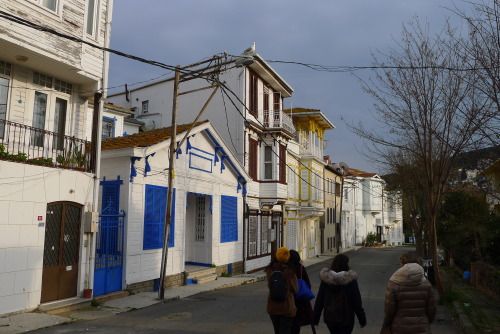
Heybeliada
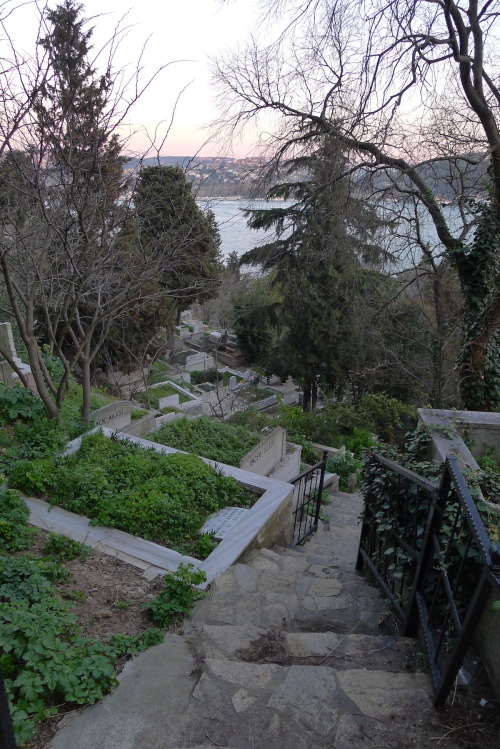
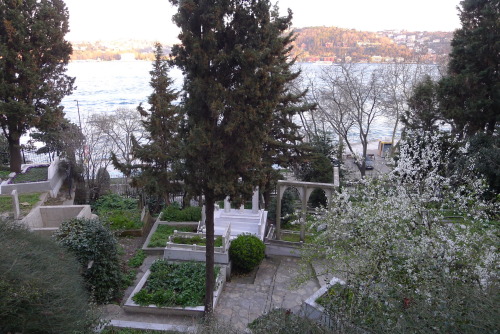
Aşiyan Mezarlığı
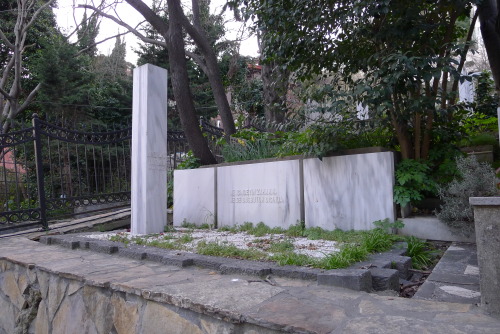
Tanpınar’s tomb
[1] A deliberate allusion to E. M. Forster’s novel A Room with a View.

